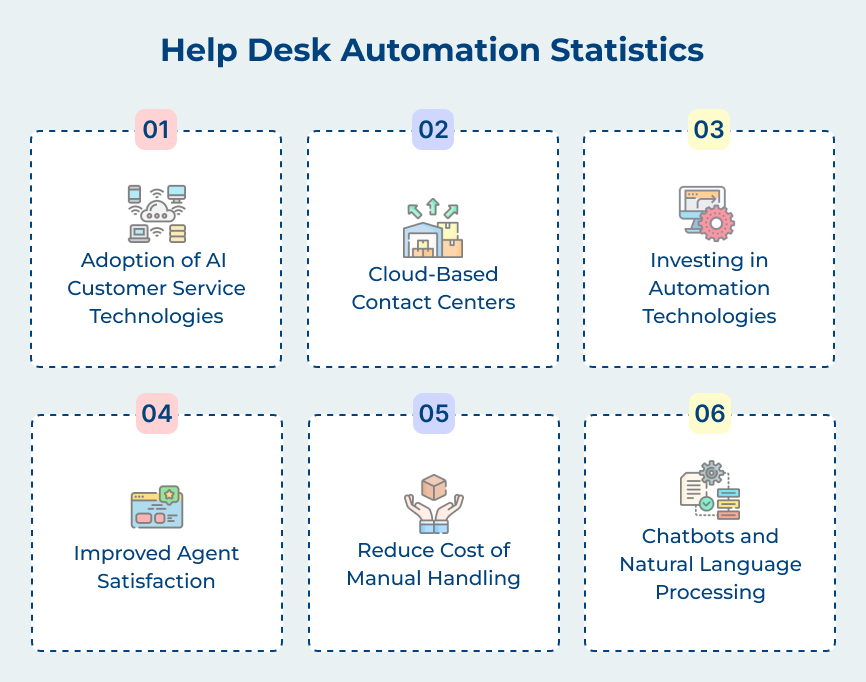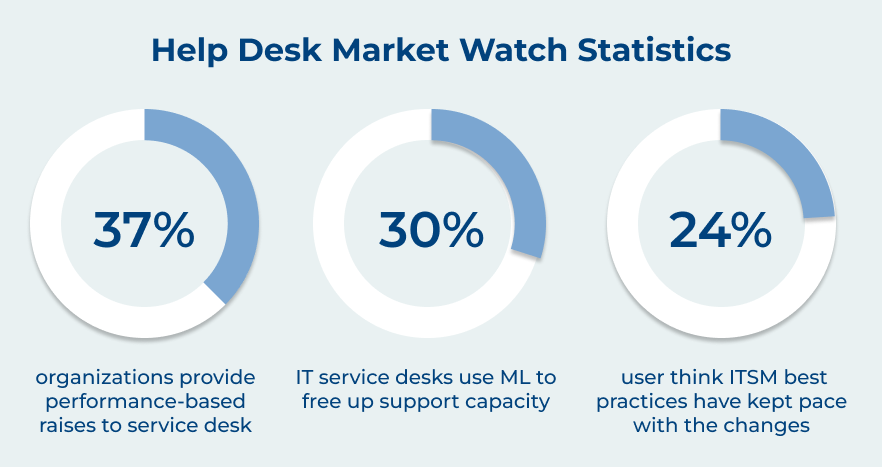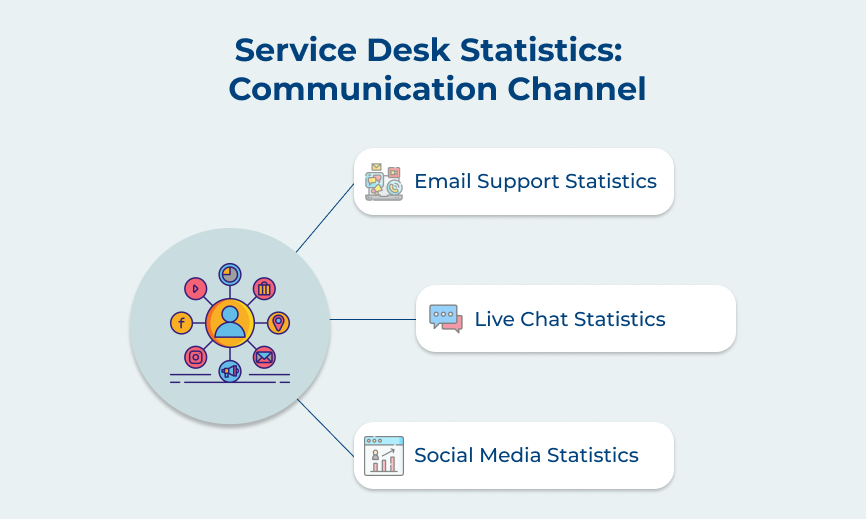High-Level Help Desk Statistics
Help desk teams are at the forefront of the effort, acting as the first point of contact for customers seeking assistance. Let’s delve into some high-level help desk stats to better understand future help desk trends.
1. Only 38% of customer experience teams offer a knowledge base.
A knowledge base is a centralized repository of information that provides customers with self-help resources and allows them to find answers to their questions independently. Despite that, only 38% of customer experience teams are known to have the valuable resource. Having a knowledge base equips customers with the tools they need to troubleshoot common issues on their own, reducing pressure on help desk agents.
2. The help desk software market share is projected to reach $10 billion by 2025.
Companies are recognizing the significance of providing top-notch customer support. There has been significant growth in the help desk software market. The market is predicted to reach a staggering value of $10 billion by 2025 with the increasing demand for streamlined customer service operations. The growth is driven by the need for efficient ticket management, automation and seamless integration with other business systems.
3. The help desk software market share is projected to reach a revised size of $24.8 Billion by 2027.
The forecast indicates a significant increase in the adoption of help desk software solutions across various industries. Organizations are increasingly realizing the potential of these platforms in streamlining support processes, promoting collaboration among teams and gathering valuable customer insights.
Customer Service Usage
Businesses are adapting to a new normal and the usage of customer service platforms has seen significant changes. Here are some key insights into the current state of customer service usage.
1. Average ticket volume has risen by 16% since the pandemic.
The global pandemic ended up causing disruptions in various industries. The majority of the customer service teams witnessed a surge in the number of customer inquiries and support requests. The average ticket volume has increased by 16% across different sectors, highlighting the growing need for effective customer service solutions.
2. Help desk software use is up 11 points from 2020, to 53% among customer service teams.
Customer service teams have turned to help desk software to efficiently manage the increased ticket volume and provide timely support. The utilization of such software has seen a significant 11-point increase from 2020, with 53% of customer service teams now employing help desk solutions. Help desk software streamlines communication, tracks customer issues and provides a centralized platform for customer service teams to resolve queries efficiently.
3. 60% of high-growth customer service teams use a help desk, significantly higher than slower-growing teams.
The success of customer service operations is closely tied to business growth. High-growth customer service teams understand the correlation and prioritize the adoption of help desk tools. Statistics indicate that 60% of these teams utilize a help desk platform, a significantly higher proportion than slower-growing teams. The use of help desk software enables high-growth teams to streamline their operations, ensure prompt response times and maintain customer satisfaction even during periods of rapid expansion.
4. Globally, help desk interactions increased on WhatsApp by 115%, SMS (20%), social media (13%) and chat (11%).
The communication preferences of customers are evolving and customer service interactions have also shifted across various channels. Globally, there has been a notable increase in help desk interactions on WhatsApp, with a staggering 111% rise. There has been a 15% increase in interactions through SMS, an 11% increase on social media platforms and a 10% increase through chat channels. The help desk stats depict the changes in customer service, with customers opting for real-time, convenient communication channels.
Help Desk Impacts
Customer expectations are higher than ever and understanding the impact of a help desk on customer satisfaction is essential for businesses looking to thrive in a competitive environment. Let’s jump into some key findings and statistics that shed light on the importance of a robust help desk system.
1. Help desk users report a satisfaction rate of about 85%
Even though it is still a significant number, it falls slightly behind direct talking at 91% and chat at 88%. It indicates that there is still room for improvement in ensuring customer satisfaction through help desk interactions. Businesses must analyze customer feedback and make continuous efforts to enhance their help desk services to meet the high satisfaction rates achieved through other channels.
2. 91% of them agreed that their help desk system increases productivity.
The service desk statistic here highlights the immense value that a well-implemented help desk can bring to a business. Streamlining support processes, automating tasks and providing efficient communication channels enables the help desk to significantly improve the productivity of customer service teams.
3. 79% of consumers say that personalized customer service is more important to them than personalized marketing.
The help desk statistics report reflects the significance of delivering exceptional support through the help desk. While personalized marketing campaigns can catch customers’ attention, it is the personalized support they receive through the help desk that truly impacts their overall experience and perception of a brand. Investing in training and empowering help desk agents to provide personalized service is key to building long-term customer loyalty.
4. 87% of customers expect to be able to move from one channel to another while having seamless conversations with agents.
There has been a growing importance of omnichannel support and the same can be seen in service desk stats. Customers want to interact with a service desk through multiple customer service channels, such as phone, email, chat or social media and expect an efficient experience regardless of the channel they choose. Implementing a help desk system that enables seamless channel transitions and ensures uniform information across platforms is crucial to meeting customers’ expectations.
Pandemic Impact
The COVID-19 pandemic has had far-reaching effects on individuals and businesses around the world. One area that has been significantly impacted is customer service. There has been a shift towards remote work and a greater reliance on digital communication. It is the reason the expectations of both B2B and B2C customers have increased.
1. 80% of B2B buyers stated that the pandemic has raised their customer service expectations.
There have been little to no in-person interactions, so B2B buyers now rely heavily on virtual communication channels to interact with businesses. They now expect faster response times, personalized attention and seamless online experiences. The increased expectation places a greater demand on businesses to adapt and deliver exceptional customer service in a virtual environment.
2. 70% of B2C customers have reported an increase in their customer service expectations due to the pandemic.
Many brick-and-mortar stores were temporarily closing or operating with limited capacity. Consumers have turned to online shopping in unprecedented numbers. The shift has resulted in a surge in online customer inquiries, product returns and requests for assistance. B2C customers now expect prompt responses, easy returns and proactive communication from businesses.
Help Desk Market Watch Statistics
Lately there have been several interesting service desk statistics that shed light on important aspects of the help desk market. Let’s take a closer look at some of the help desk stats facts and their implications.















